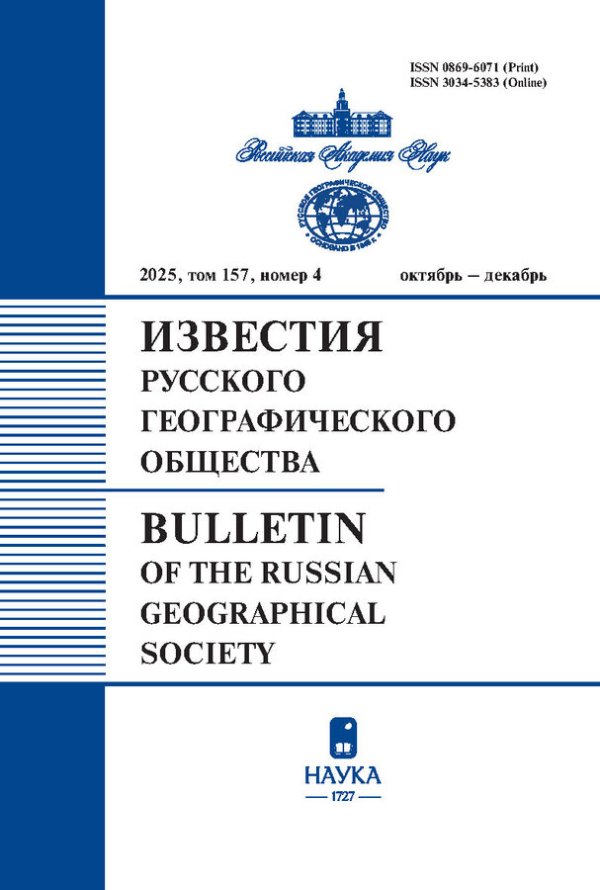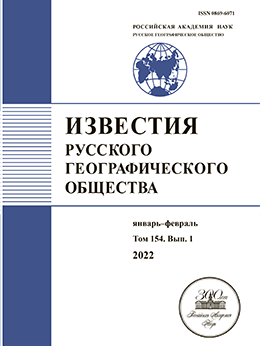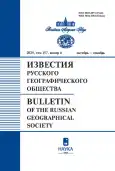Известия Русского географического общества
Cтарейший географический журнал России и один из авторитетных научных географических журналов мира; издается с 1865 г.
Структура журнала включает: оригинальные статьи, отражающие результаты новейших географических исследований; дискуссии; рецензии; хронику.
Свидетельство о регистрации СМИ: № 0110279 от 08.02.1993
Учредители
- Российская академия наук
- Русское географическое общество РАН
- Институт озероведения Российской академии наук
Главный редактор
- Касимов Николай Сергеевич, академик РАН, доктор географических наук, профессор
Периодичность / доступ
4 выпуска в год / подписка
Входит в
Белый список (3 уровень), перечень ВАК (К1), РИНЦ, ядро РИНЦ, RSCI
«Известия Русского географического общества» предоставляет трибуну для обсуждения актуальных проблем, сложных и дискуссионных вопросов географической науки. Предпочтение отдается статьям и сообщениям, содержание которых может представлять интерес для широкого круга специалистов-географов и представителей смежных дисциплин. Редакционная коллегия поддерживает перспективные направления в географии, в особенности работы по проблемам рационализации природопользования, сохранения природного разнообразия, регионального развития и пространственной организации общества, а также междисциплинарные исследования на стыке географии и других естественных и гуманитарных наук.
Система научного рецензирования и редактирования, принятая редколлегией журнала, обеспечивает высокий уровень публикуемых материалов и соответствие их профессиональным критериям.
Текущий выпуск
Том 157, № 4 (2025)
Статьи
Сельские территории в фокусе географических исследований
Аннотация
 471-485
471-485


РОЛЬ НИЗОВОЙ САМООРГАНИЗАЦИИ НАСЕЛЕНИЯ В РАЗВИТИИ ПЕРИФЕРИЙНОЙ СЕЛЬСКОЙ МЕСТНОСТИ
Аннотация
 486–504
486–504


Дифференциация социально-экономического пространства сельских населенных пунктов Ставропольского края
Аннотация
 505-526
505-526


ЭТНОКОНТАКТНЫЕ ЗОНЫ СЕЛЬСКОЙ МЕСТНОСТИ: ПРИМЕР КУРУМКАНСКОГО РАЙОНА РЕСПУБЛИКИ БУРЯТИЯ
Аннотация
 527–551
527–551


ПРОСТРАНСТВЕННО-ВРЕМЕННЫЕ ЗАКОНОМЕРНОСТИ РАЗВИТИЯ ЗЕРНОВОГО ХОЗЯЙСТВА РОССИИ
Аннотация
 552-568
552-568


ПОСТСОВЕТСКИЕ ТРАНСФОРМАЦИИ СЕЛЬСКОГО ХОЗЯЙСТВА В РЕСПУБЛИКЕ АЛТАЙ
Аннотация
 569–594
569–594


РОЛЬ СЕЛЬСКОГО ТУРИЗМА В ДИВЕРСИФИКАЦИИ ЭКОНОМИКИ СЕЛЬСКИХ ПОСЕЛЕНИЙ
Аннотация
 595-610
595-610


ТРАНСПОРТНАЯ ДОСТУПНОСТЬ ОБЪЕКТОВ СЕЛЬСКОГО ТУРИЗМА ЮЖНОЙ ЧАСТИ ИРКУТСКОЙ ОБЛАСТИ
Аннотация
 611–634
611–634


РОЛЬ СЕЛЬСКИХ ТЕРРИТОРИЙ В СТРАТЕГИЯХ СОЦИАЛЬНО-ЭКОНОМИЧЕСКОГО РАЗВИТИЯ РЕГИОНОВ ЮГА ЗАПАДНОЙ СИБИРИ
Аннотация
 635–654
635–654


ЖИЗНЕСТОЙКОСТЬ КУСТОВОГО ЦЕНТРА СЕЛЬСКОГО РАССЕЛЕНИЯ НА ПРИМЕРЕ ПОСЕЛКА ОКТЯБРЬСКОЕ, РЕСПУБЛИКА КРЫМ
Аннотация
 655–671
655–671


ФАКТОРЫ ФОРМИРОВАНИЯ СЕТИ ПОСЕЛЕНИЙ НА ТЕРРИТОРИИ ОМСКОЙ ОБЛАСТИ
Аннотация
 672–688
672–688










